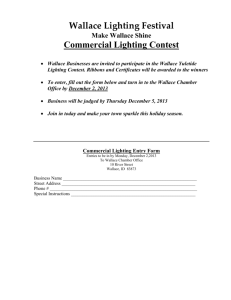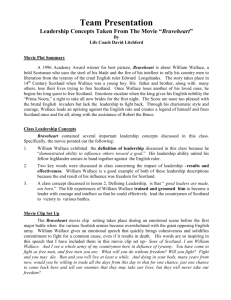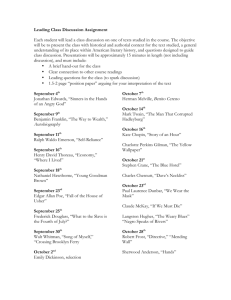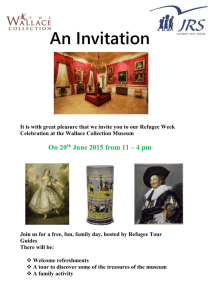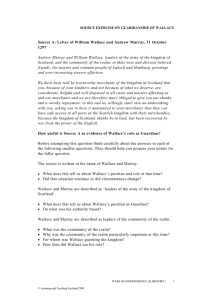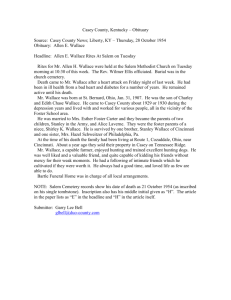W ILLIAM ALLACE
advertisement
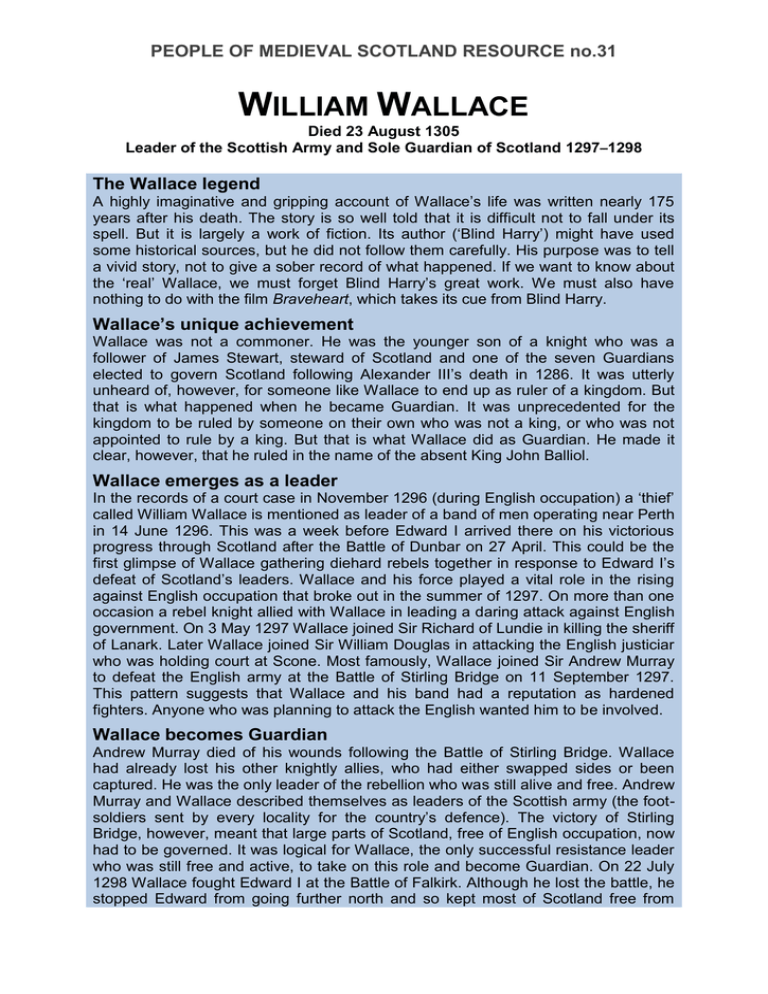
PEOPLE OF MEDIEVAL SCOTLAND RESOURCE no.31 WILLIAM WALLACE Died 23 August 1305 Leader of the Scottish Army and Sole Guardian of Scotland 1297–1298 The Wallace legend A highly imaginative and gripping account of Wallace’s life was written nearly 175 years after his death. The story is so well told that it is difficult not to fall under its spell. But it is largely a work of fiction. Its author (‘Blind Harry’) might have used some historical sources, but he did not follow them carefully. His purpose was to tell a vivid story, not to give a sober record of what happened. If we want to know about the ‘real’ Wallace, we must forget Blind Harry’s great work. We must also have nothing to do with the film Braveheart, which takes its cue from Blind Harry. Wallace’s unique achievement Wallace was not a commoner. He was the younger son of a knight who was a follower of James Stewart, steward of Scotland and one of the seven Guardians elected to govern Scotland following Alexander III’s death in 1286. It was utterly unheard of, however, for someone like Wallace to end up as ruler of a kingdom. But that is what happened when he became Guardian. It was unprecedented for the kingdom to be ruled by someone on their own who was not a king, or who was not appointed to rule by a king. But that is what Wallace did as Guardian. He made it clear, however, that he ruled in the name of the absent King John Balliol. Wallace emerges as a leader In the records of a court case in November 1296 (during English occupation) a ‘thief’ called William Wallace is mentioned as leader of a band of men operating near Perth in 14 June 1296. This was a week before Edward I arrived there on his victorious progress through Scotland after the Battle of Dunbar on 27 April. This could be the first glimpse of Wallace gathering diehard rebels together in response to Edward I’s defeat of Scotland’s leaders. Wallace and his force played a vital role in the rising against English occupation that broke out in the summer of 1297. On more than one occasion a rebel knight allied with Wallace in leading a daring attack against English government. On 3 May 1297 Wallace joined Sir Richard of Lundie in killing the sheriff of Lanark. Later Wallace joined Sir William Douglas in attacking the English justiciar who was holding court at Scone. Most famously, Wallace joined Sir Andrew Murray to defeat the English army at the Battle of Stirling Bridge on 11 September 1297. This pattern suggests that Wallace and his band had a reputation as hardened fighters. Anyone who was planning to attack the English wanted him to be involved. Wallace becomes Guardian Andrew Murray died of his wounds following the Battle of Stirling Bridge. Wallace had already lost his other knightly allies, who had either swapped sides or been captured. He was the only leader of the rebellion who was still alive and free. Andrew Murray and Wallace described themselves as leaders of the Scottish army (the footsoldiers sent by every locality for the country’s defence). The victory of Stirling Bridge, however, meant that large parts of Scotland, free of English occupation, now had to be governed. It was logical for Wallace, the only successful resistance leader who was still free and active, to take on this role and become Guardian. On 22 July 1298 Wallace fought Edward I at the Battle of Falkirk. Although he lost the battle, he stopped Edward from going further north and so kept most of Scotland free from English occupation. He resigned as Guardian, however, and took on a new role as a diplomat on the Continent. Wallace’s death On 9 February 1304 Edward I agreed terms and received the surrender of John the Red Comyn and nearly all the other Scottish leaders who fought in the name of the absent King John Balliol. Edward insisted, however, on Wallace’s unconditional surrender. There is no evidence, however, that Wallace wanted peace with Edward. Once more he was the leader of a band of diehards resisting Edward’s conquest of Scotland. King Edward put pressure on leading Scots to capture Wallace. Even so, Wallace remained free for a year and a half until he was taken near Glasgow on 3 August 1305. Instead of executing him in Scotland, Edward I decided to bring him south so that his death would be a spectacle for throngs of people attending one of the biggest fairs in London. On 23 August Wallace was brutally killed as a traitor and for committing sacrilege. His head was put on show in London, and his body was divided into sections that were displayed in Newcastle, Berwick, Stirling and Perth. November 1296 The king’s lawmen hear an accusation that a theft that took place in Perth by William Wallace. Matthew of York was to answer Christiana of Perth on a plea of robbery. Christiana complains that on the Thursday before the feast of St Botulph in 1296 [14 June] Matthew came to Perth in the company of a thief named William Wallace and carried off her possessions against her wishes, which he found in her house, including 3s. worth of beer [about £80 today], to Christiana’s damage and against the peace. She brings him to court on this matter. Matthew says that he does not have to answer Christiana because he is a priest. Therefore an investigation is made. The jurors say that Matthew came to the town in the company of William Wallace and that he carried off Christiana’s goods as she charged him. Therefore he is condemned to penance. 3 May 1297 William Wallace kills the sheriff of Lanark. (Taken from the Schøyen chronicle.) In the year of Our Lord 1297, the Scots rose up, namely William Wallace and Richard of Lundie, who had gathered together a band of men, and they killed the sheriff of Lanark on the day of the Finding of the Holy Cross [3 May]. Berwick: 23 July 1297 Letter from Hugh Cressingham (the treasurer) to Edward I, advising that an attack be made on William Wallace, who was in Selkirk Forest with a large company of men. Sire, at Berwick on 14 July, I received two of your letters, delivered by John Brehille and William Ledbury, your messengers. The second letter says that if you could capture of the earl of Carrick [Robert Bruce], the Steward of Scotland [James Stewart], and his brother [John Stewart] (who are supporters of the insurrection), you would think your business in Scotland finished. You have given me the task of employing all my skill, using the money which you have sent me, and every other means in my power, to accomplish this. 2 Sire, before your letters reached me, I had been at Bolton moor in the county of Northumberland on the advice of your council (which was then at Berwick). On 10 July, the most important people of the county came to meet me there. We decided to make an expedition against the enemy on the Thursday before the feast of St Margaret [Thursday 18 July], provided that the army arrived at Roxburgh on the Tuesday before that Thursday. The army was assembled on the Wednesday in Roxburgh. We had 300 mounted soldiers and 10,000 foot-soldiers in total. And we would have made the expedition had not it been for Sir Henry Percy and Sir Robert Clifford, who arrived on the Wednesday evening in Roxburgh and told us that they had received all of your enemies on this side of the Scottish Sea [i.e. south of the River Forth] into your peace. We told them that even though peace had been made on this side of the Scottish Sea, it would be better to attack the enemies on the other side, or attack William Wallace, who lay there with a large company of men in Selkirk forest. It was decided that no expedition should be made until the arrival of the earl of Warenne, your guardian of Scotland. If you do not know all the details about the peace, I send a full explanation under the seal of the bishop of Glasgow, along with a confidential letter of his, and a letter containing confidential matters which his clerk told me. Sire, please do not be offended that I have delayed your messenger for so long: to tell the truth, I have been very annoyed that I have not been able to give you better news. I am keeping William Ledbury, your other messenger, with me (with your permission): I shall send him with better news after the arrival of the earl, God willing. May God save and keep your noble lordship! Stirling: 11 September 1297 Hugh Cressingham is killed at the Battle of Stirling Bridge, and skinned by William Wallace. (From the Chronicle of Lanercost Priory.) The Scots allowed as many of the English to cross the bridge as they could hope to overcome, and then, having blocked the bridge, they slaughtered all who had crossed over, among whom perished the Treasurer of England, Hugh Cressingham, of whose skin William Wallace caused a broad strip to be taken from the head to the heel, to make with it a belt for his sword. Haddington: 11 October 1297 Andrew Murray and William Wallace write to the mayors and people of Lübeck and Hamburg (Northern Germany) to thank them for helping the Scots and their merchants. They also tell them that their merchants will be able to trade safely with Scotland because the Scottish army has defeated the English. Andrew Murray and William Wallace, leaders of the army of the kingdom of Scotland and the community of the kingdom, to their friends the mayors and citizens of Lübeck and Hamburg: greeting. We have been told by trustworthy merchants of the kingdom of Scotland that you are giving advice, help and favour in all causes and business concerning us and our merchants, for which we thank you. We ask that you tell your merchants that they can have safe access to all the ports in the kingdom of Scotland, since Scotland (thanks be to God) has been rescued from the power of the English by force of arms. Farewell. 3 Between 20 November 1297 and 19 October 1298 Two of Edward I’s soldiers write to him to ask if he can help them pay back the merchants of England for goods they took to pay his army when Berwick was recaptured from Wallace. Peter Deneven and Robert Herouh to our lord the king and his council: greeting. We write to tell you that, when you were in Flanders, the earl of Warenne, guardian of Scotland, with the earls and barons of England who were in his company, recovered the town of Berwick, which William Wallace and other enemies of the king had seized in the 26th year of your reign [1297/8]. The earls and barons told the guardian that they could not well remain there unless the foot-soldiers were properly paid. So we, by the earl’s order, took supplies from the merchants of England and other merchandise to the value of 1000 marks and more [about £350,000 today] to pay them. Since the merchants are now suing us for this money, we ask you, our lord king, to order the chamberlain to compensate the merchants so that we may be discharged. Torphichen (West Lothain): 29 March 1298 William Wallace, as a knight, Guardian of Scotland and leader of the army, gives to Alexander Scrymgeor land in Dundee and the post of keeper of Dundee Castle. The gift is given in the name of John Balliol, king of Scots, and with the approval of the whole kingdom. William Wallace, knight, Guardian of the kingdom of Scotland and leader of the army of Scotland, in the name of the lord John Balliol, king of Scots, by the consent of the community of the kingdom state that I, by the consent of the magnates of the kingdom, have given lands to Alexander Scrymgeour in the territory of Dundee: namely the land called Great Field, with the acres in the field to the west which belonged to the king, and the meadow of the king in the territory of Dundee. And in addition, I give him the office of constable of Dundee castle, for homage to be made to the king and his heirs, and faithful service and aid to the kingdom. And he is to carry the banner of the king in the army from the time of the present agreement. Govan: 5 December 1298 A charter of Robert Bruce, confirming William Wallace’s gift of land in Dundee and post of castle keeper to Alexander Scrymgeour (28 March 1298). Robert Bruce, earl of Carrick, one of the Guardians of the realm of Scotland, to the sheriff of Forfar and his officials: greeting. I understand that Alexander Scrymgeour has been given possession of Dundee Castle and certain other lands near to the town by the gift of Sir William Wallace. I therefore command you to give him possession of the castle and these lands, both in my name and in the name of Sir John Comyn, my fellow-guardian of the realm of Scotland. Alexander should have them in the same way that is described by the gift of the said Sir William Wallace before we entered into the guardianship of the realm. 4 7 November 1300 Philip IV commands his diplomats at Rome to put in a good word for William Wallace with the Pope. Philip, by the grace of God king of the French, to my beloved and faithful agents appointed to the Pope’s Court: greeting. I command you to ask the Pope to consider my beloved William Wallace of Scotland, knight, with favour when the Pope has his discussion with Wallace. Dunfermline: 2 March 1304 Edward I commands the earl of Dunbar to watch the enemy closely and thoroughly. (The enemy is William Wallace and others who did not take part in the general surrender to Edward I on 9 February 1304.) King Edward to the earl of March [the earl of Dunbar], greeting: I understand that you are delaying dealing with my enemies until they leave the area, and I am astonished that you proceed so slackly. But I now require you to move to the area around Dunipace, the Torres [Torwood] and the Polles [Carse of Stirling]. From there you should watch the enemy as best as you can, using your own troops and those of the district, so that the enemy should not by any means be able to reach Stirling Castle, nor come near you without their great loss. I wish that you would do this task with all diligence until about this next Mid-Lent Sunday. If you are with me at St Andrews on the Monday following at my Mass, this will be in very good time. And direct the people of the counties of Stirling and all those districts. Buy all that they can spare us, so that they will raise the cry against my enemies as loudly as possible if they find them, both by horns and voice, and they will pursue the enemy so vigorously that they shall not be found to be lazy. I am about to leave Dunfermline, on my way towards St Andrews. The country around that place is now so empty of inhabitants and forces that those of the castle of Stirling may attempt to cross the River Forth to do some damage on this side. I therefore wish that you make sure the enemy is carefully watched, for if they make such an expedition across the Forth, I think that they would surely lose some of their men on their return, either through you who could come in their rear, or by your other people who guard the country there in front of the fords of the river. Kinghorn (Fife): 3 March 1304 Edward I tells Sir Alexander Abernethy that he should not offer any words of peace to William Wallace or any of his men. King Edward to Sir Alexander of Abernethy: greeting. I have carefully read your letter in which you told me that you are remaining in Scotland to watch over the fords of the River Forth. I order you to employ all of your efforts in the matter, and to find William Bisset, the sheriff of Clackmannan, to assist in the watch if necessary. I wish that you do not leave Scotland until you have sent further news to me. Your letter also asked whether it is my wish that you should extend any words of peace to William Wallace. I tell you now that it is not by any means my pleasure that you should give any word of peace either to William or to any other men of his company, unless they place themselves absolutely and in all things at our will, without any exception whatsoever. 5 23 August 1305 An eyewitness account: William Wallace is executed in London. (From the Chronicle of the Mayors and Sheriffs of London.) On Monday, Saint Bartholomew’s Eve [23 August], in the thirty-third year of king Edward, William Wallace, a knight of Scotland, was condemned in the king’s hall at New Palace [Westminster] to be drawn, hanged, beheaded, his bowels burnt, his body dismembered, torn apart into four pieces, and his head on London Bridge on a pike, for treason committed against Edward, king of England and Scotland. Expenses for the execution of William Wallace and the transportation of his body from London to Scotland. (29 September 1305: From the financial accounts of Edward I) Citizens of London, John of Lincoln and Roger of Paris, sheriffs of London and Middlesex, account for their spending. As expenses and payments made by these sheriffs for William Wallace, as a robber, a public traitor, an outlaw, an enemy and rebel against the king, who in contempt of the king had, throughout Scotland, falsely sought to call himself king of Scotland, and slew the king’s officials in Scotland, and also as an enemy led an army against the king, by sentence of the king’s court at Westminster drawn, hanged, beheaded, his entrails burned, and his body quartered, whose four parts were dispatched to the four principal towns of Scotland. This year they have paid: 61 shillings 10 pence [about £1,600 today]. (From the records of the king’s government) John of Lincoln and Roger of Paris, sheriffs of London, state that they have paid 15 shillings [about £350 today] to John of Seagrave in the month of August in the 33rd year [1305] for the transport of the body of William Wallace to Scotland. (From a book of payments in the king’s personal spending accounts) Payment made to Sir John Seagrave, as an advance for transporting the body of William Wallace the Scot, divided into four parts, to Scotland … Payment was made by the hands of John of Lincoln and Roger of Paris, sheriffs of London: 15 shillings [about £350 today]. Winchester: 21 April 1306 Reward paid to Adam Bruning for helping capture William Wallace. Payment made to Adam Bruning, who was at the capture of Sir William Wallace, staying in England for some time in February and March 1306, for his reward from the king for this capture, and going by the king’s order to Scotland on the king’s business: 100s. [about £2,500 today] Perth: 1 September 1305 Investigation into why a man called Michael of Meigle was in William Wallace’s army. Investigation at Perth on the Wednesday after the feast of the Beheading of Saint John the Baptist, in the king’s 33rd year [1 September 1305], in front of Malise, earl of Strathearn, lieutenant of the warden north of the Forth, and Malcolm of Innerpeffray, knight, deputy of the chamberlain, John of Sandale, and William of Bevercotes, chancellor of Scotland. Articles were brought forth concerning the person of Michael of Meigle written by 6 25 men who say on oath, in Michael’s presence, that he had recently been taken prisoner by force and against his will by William Wallace; that he escaped once from William for two leagues [about 6 miles] but was pursued and brought back by some armed accomplices of William’s, who was firmly resolved to kill him for his flight; that he escaped another time from William for three leagues [about 9 miles] or more and was again brought back a prisoner by force with the greatest violence and barely avoided death at William’s hands, had not some accomplices of William pleaded for him. Upon which, he was told that if he tried to get away a third time, he would lose his life. Thus it appears he remained with William through fear of death and not of his own will. The earl, Sir Malcolm, and some of the others, append their seals. 7


